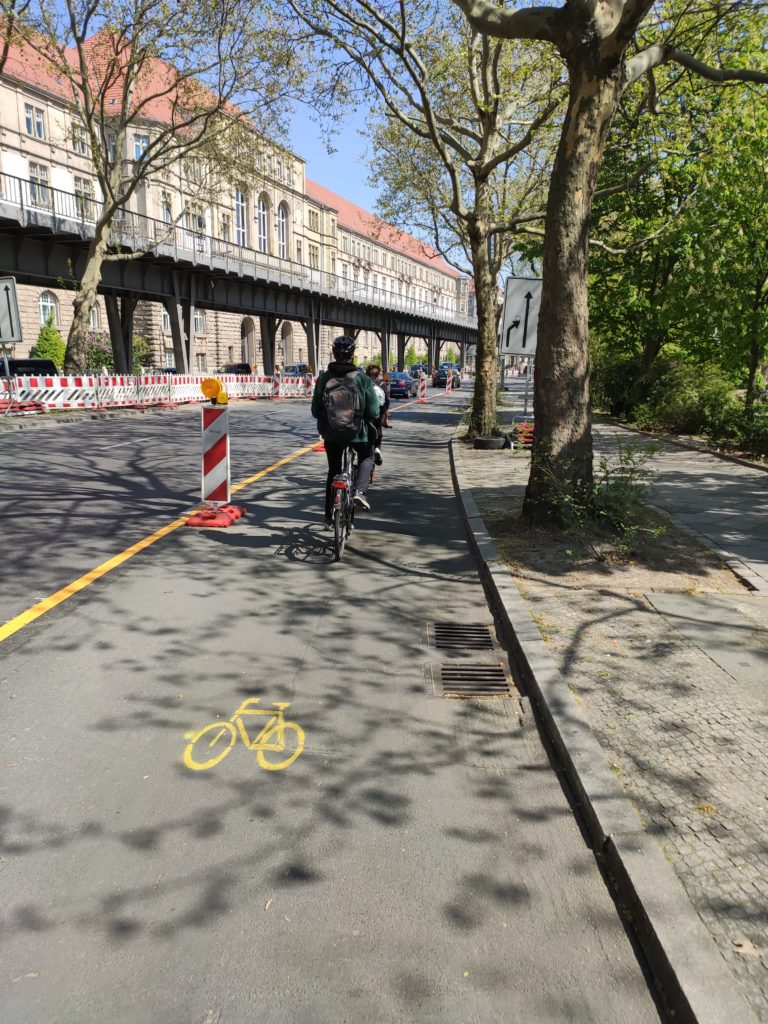Pedalling our way through the pandemic
Pop-up bike lanes as a countermeasure to fight COVID
“I don’t believe in Peter Pan, Frankenstein or Superman – All I wanna do is
Bicycle, bicycle, bicycle
I want to ride my bicycle, bicycle, bicycle” (Queen, 1978)
From Berlin to Bordeaux, from Brussels to Budapest: In the first half of 2020 many cities worldwide opened up temporary or permanent cycle lanes in order to encourage sustainable transport in COVID times. According to a German study, on average 11.5 kilometres of provisional pop-up bike lanes have been built per city by August 2020. Some have seized this opportunity to implement measures that were already planned long ago, others to test out new strategies. Few policy measures have been given this level of visibility in the urban landscape: pop-up bike lanes are usually marked with big yellow lines and traffic cones and replace the right-hand lane or a previous parking lane. Costs per kilometre of provisional lane seem to vary widely, from €9,500 in Berlin to €25,000 in Sevilla.
What started in Bogotá, Colombia, was first imitated in Europe by a Berlin district on 25 March 2020. 8 other cities in Germany followed with a total outcome between March and August of around 25.5 km of pop-up lanes (situation as of September 2020, according to ZEIT magazine no.38). Stuttgart has even received state recognition and has won an award for its quick decision-making and the demonstration value of its cycling measures. When Covid started, city officials created an additional cycling provision with new lanes in otherwise busy streets. Long before the pandemic, the city, which is home to car manufacturer Porsche, decided to shape its profile both as a car and a bike city. In a long-term perspective, cycling should account for 25% of the city’s mobility. To reach this objective, the city plans an annual investment of €40/resident in cycling infrastructure.

Bolder budget for bikes
Last May, the UK government made £250 million available to enable local authorities to pay for “pop-up” cycling and walking infrastructure. In France, 1 million bikes were repaired and 50 jobs created last year thanks to a COVID-related governmental repair bonus (€50 /bike) for residents. And according to the association “Vélo & territoires” bike traffic since the beginning of the year 2020 has increased by 13% in urban areas compared to the same period in 2019. Success was even bigger in Belgium: the public initiative Bike for Brussels, for example, recorded a stunning 84% increase in cyclists over a 1-year stretch compared to September 2019. One of the reasons could be the 40 km of new cycle lanes built by Brussels-Capital between March and July 2020. Ireland aims to make a green recovery and has earmarked €360 million to boost cycling in 2021.
In The Netherlands, a traditional biking paradise, The Hague plans to invest €65 million (€126 per resident) in its cycling network. This budget is earmarked in the “Plenty of Space for Cycling Programme 2020-2025” which was published last December. It will bring The Hague closer to its target of making cycling its primary mode of transport by 2040. As much as possible, work on cycle paths is done at the same time as other activities in the city such as maintenance of the road surface or sewerage or safety improvement measures. Where possible, the municipality collaborates with regional and national partners. After testing larger cycling lanes and more space at traffic lights, neighbouring Rotterdam has decided to permanently create more space for cyclists in the future years (Fietskoers 2025).
Corona lane battles
However, corona bike lanes have not always popped up without conflict. The temporary measure had a very short life span in Marseille, where the corona cycling lane disappeared after only one week. City officials argued that the 9km lane (that cost almost €600,000 in total) had not been used enough. A few months and many critic voices later, discussions around the creation of 23 new corona lanes were resumed by Marseille city council last November. Some of the councillors see an urgent need for going far beyond the currently available 100 cycleable kilometres when smaller cities like Strasbourg have 600 km and the French capital Paris boasts 800 km.
Similarly, in Berlin, pop-up bike lanes have not received enthusiastic support from everyone. The new cycling space triggered opposition from groups like the German automobile club ADAC and political parties like CDU, FDP and AFD accused the district officials of favouring bikes over cars. A fight over Berlin’s streets has started since then and a legal case against the Senate is still pending.

Long-term effects
If political priorities are set, decisions can be taken quickly in order to respond to urgency. In that sense, Covid has been a great lesson and has proven that tactical urbanism can become strategic urbanism if the political will is there. A survey amongst 105 local authorities in France whose results were published in October 2020 confirms this: a majority of respondents plan to turn pop-up lanes into permanent cycling infrastructure. The few respondents, just 8%, declaring the corona lane will not last explained that this is due to either a lack of acceptability or the conscious choice for a more conventional infrastructure backed by public consultation procedures.
A German study published in September 2020 shows that the temporary corona cycle paths in European cities together represent savings of €2.3 billion euros per year for the health system.
Whether urban cycling becomes massive in the post-corona era will also depend on bold decisions at the EU level. For the time being, the EU mobility strategy misses out on the opportunities from so-alled active mobility, i.e. walking and cycling. As Euractiv reported last December, cycling did not even make it into the Commission’s 10 action points for the sustainability shift.
The Brussels-based European Cyclists’ Federation assessed the 27 draft and final NECPs for 2021– 2030 against 13 cycling or sustainable mobility-related indicators. Member States have begun to take the decarbonisation potential of cycling more seriously, but there is still a long way to go, as highlighted in the ECF report “Cycling underrepresented in EU Member States’ Final National Energy and Climate Plans”, published on 8 October. Only France and Austria were ranked as “excellent”.
Providing good cycling paths and making cycling accessible and safe needs to become a priority in national and local energy and climate action plans. But one lesson that we have learnt from pop-up lanes is that policy-making can (and sometimes must) be quick and pragmatic. Quick unconventional measures in times of uncertainty can help policy-makers on their ride to the pandemic-resilient city of tomorrow. Or, as we bikers would say: Sometimes, you can fix a dropped chain without getting off your bike.

